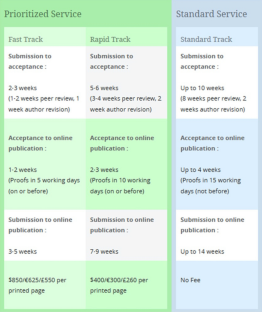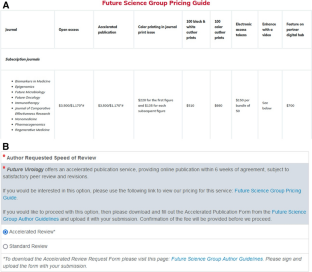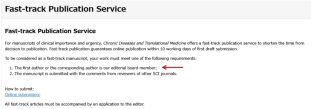Abstract
Some journals and publishers offer a free or paid rapid peer review service. In the latter case, such a service is offered at a premium, i.e., for an additional fee, and authors receive, in return, a privileged service, namely faster peer review. In the cut-throat world of survival in academia, the difference of a few weeks or months in terms of speed of peer review and publication may bring untold benefits to authors that manage to benefit from accelerated peer review. We examine the deontological aspects behind this two-tier peer review system, including some positive, but mainly negative, aspects. Some paid accelerated peer review services thrive. We examine the paid accelerated peer review services by Taylor & Francis, Future Medicine Ltd., Elsevier, and two stand-alone journals that are OASPA members. This suggests that there is a demand, and thus market, for faster peer review. However, this privilege risks creating a two-tiered system that may divide academics between those who can pay versus those who cannot. We recommend that those papers that have benefited from accelerated peer review clearly indicate this in the published papers, as either a disclaimer or within the acknowledgements, for maximum transparency of the peer review and publication process.



Similar content being viewed by others
Explore related subjects
Discover the latest articles and news from researchers in related subjects, suggested using machine learning.Data availability
The last access date to all websites was 5 February 2022.
Change history
03 November 2022
A Correction to this paper has been published: https://doi.org/10.1007/s12109-022-09928-8
Notes
COPE: https://publicationethics.org/resources/guidelines-new/principles-transparency-and-best-practice-scholarly-publishing; DOAJ: https://blog.doaj.org/2018/01/15/principles-of-transparency-and-best-practice-in-scholarly-publishing-version-3/; OASPA:https://wame.org/principles-of-transparency-and-best-practice-in-scholarly-publishing; WAME: https://wame.org/principles-of-transparency-and-best-practice-in-scholarly-publishing.
This information was not always public: https://twitter.com/tandfonline/status/953987607993692161; https://ease.org.uk/2018/01/tandfreviewerpayments/.
The original URL for “Prioritized Service” (http://taylorandfrancis.com/partnership/commercial/prioritized-publication-options/) is now defunct and is automatically rerouted to the current URL for “Accelerated Publication”. However, some screenshots have been archived: https://web.archive.org/web/*/http://taylorandfrancis.com/partnership/commercial/prioritized-publication-options/ (2016–2021).
https://www.futuremedicine.com/authorguide/submittrackarticle (“Submitting & tracking your article”).
https://publicationethics.org/members/future-science-oa (the publisher is listed as Future Science Ltd).
References
Teixeira da Silva JA, Al-Khatib A, Katavić V, Bornemann-Cimenti H. Establishing sensible and practical guidelines for desk rejections. Sci Eng Ethics. 2018;24(4):1347–65. https://doi.org/10.1007/s11948-017-9921-3.
Teixeira da Silva JA, Dobránszki J. Excessively long editorial decisions and excessively long publication times by journals: Causes, risks, consequences, and proposed solutions. Publ Res Q. 2017;33(1):101–8. https://doi.org/10.1007/s12109-016-9489-9.
Kumar MN. Review of the ethics and etiquettes of time management of manuscript peer review. J Acad Ethics. 2014;12(4):333–46. https://doi.org/10.1007/s10805-014-9220-4.
Atjonen P. Ethics in peer review of academic journal articles as perceived by authors in the educational sciences. J Acad Ethics. 2018;16(4):359–76. https://doi.org/10.1007/s10805-018-9308-3.
Nguyen VM, Haddaway NR, Gutowsky LF, Wilson AD, Gallagher AJ, Donaldson MR, Hammerschlag N, Cooke SJ. How long is too long in contemporary peer review? Perspectives from authors publishing in conservation biology journals. PLoS ONE. 2015;10(8):e0132557. https://doi.org/10.1371/journal.pone.0132557; corrigendum: https://doi.org/10.1371/journal.pone.0139783
Scanff A, Naudet F, Cristea IA, Moher D, Bishop DVM, Locher C. A survey of biomedical journals to detect editorial bias and nepotistic behavior. PLoS Biol. 2021;19(11):e3001133. https://doi.org/10.1371/journal.pbio.3001133.
Teixeira da Silva JA, Katavić V. Free editors and peers: squeezing the lemon dry. Ethics & Bioethics. 2016;6(3–4):203–9. https://doi.org/10.1515/ebce-2016-0011.
Nwagwu WE, Onyancha B. Back to the beginning – the journal is dead, long live science. J Acad Librariansh. 2015;41(5):669–79. https://doi.org/10.1016/j.acalib.2015.06.005.
Larivière V, Haustein S, Mongeon P. The oligopoly of academic publishers in the digital era. PLoS ONE. 2015;10(6): e0127502. https://doi.org/10.1371/journal.pone.0127502.
Grossmann A, Brembs B. Current market rates for scholarly publishing services. F1000Research. 2021. https://doi.org/10.12688/f1000research.27468.2.
Bourne PE, Polka JK, Vale RD, Kiley R. Ten simple rules to consider regarding preprint submission. PLoS Comput Biol. 2017;13(5): e1005473. https://doi.org/10.1371/journal.pcbi.1005473.
Teixeira da Silva JA. The preprint debate: what are the issues? Med J Armed Forces India. 2018;74(2):162–4. https://doi.org/10.1016/j.mjafi.2017.08.002.
Merton RK. The Matthew effect in science: The reward and communication systems of science are considered. Science. 1968;159(3810):56–63. https://doi.org/10.1126/science.159.3810.56.
Teixeira da Silva JA. Three new suggested guidelines for increased transparency regarding open access article processing charges (APCs). Epistēmēs Metron Logos. 2020;4:4–7. https://doi.org/10.12681/eml.24208.
Teixeira da Silva JA, Nazarovets S. Publication history: A double DOI-based method to store and/or monitor information about published and corrected academic literature. J Schol Publ. 2022;53(2):85–108. https://doi.org/10.3138/jsp.53.2.2017-0017.
Ghali WA, Cornuz J. Early uptake of research findings after fast-track publication. Lancet. 2000;355(9203):579–80. https://doi.org/10.1016/S0140-6736(05)73234-7.
Teixeira da Silva JA, Dobránszki J, Tsigaris P, Al-Khatib A. Predatory and exploitative behaviour in academic publishing: An assessment. J Acad Librariansh. 2019;45(6): 102071. https://doi.org/10.1016/j.acalib.2019.102071.
Tennant JP, Ross-Hellauer T. The limitations to our understanding of peer review. Res Integrity Peer Rev. 2020;5:6. https://doi.org/10.1186/s41073-020-00092-1.
Funding
Although this study and project was not funded, YY was Funded by JSPS KAKENHI (16H03079, 17H00875, 18K12015, 20H04581, and 21H03784). JTS is not funded.
Author information
Authors and Affiliations
Contributions
The authors contributed equally to the intellectual discussion underlying this paper, literature exploration, writing, reviews, and editing, and accept responsibility for the content of this paper.
Corresponding authors
Ethics declarations
Conflict of interest
The first author was banned in 2015 from submitting to any Taylor & Francis journals in response to the author’s criticism of several of the publisher’s editorial and publishing processes, including the APR critiqued in this paper. That ban was not made public by Taylor & Francis. Other than this, the authors declare no conflicts of interest of relevance to this topic.
Ethical approval
The opinions expressed are exclusively of the authors and do not necessarily reflect the views of the affiliated institutions, in the case of the second author.
Additional information
Publisher's Note
Springer Nature remains neutral with regard to jurisdictional claims in published maps and institutional affiliations.
Rights and permissions
Springer Nature or its licensor (e.g. a society or other partner) holds exclusive rights to this article under a publishing agreement with the author(s) or other rightsholder(s); author self-archiving of the accepted manuscript version of this article is solely governed by the terms of such publishing agreement and applicable law.
About this article
Cite this article
Teixeira da Silva, J.A., Yamada, Y. Accelerated Peer Review and Paper Processing Models in Academic Publishing. Pub Res Q 38, 599–611 (2022). https://doi.org/10.1007/s12109-022-09891-4
Published:
Issue Date:
DOI: https://doi.org/10.1007/s12109-022-09891-4




